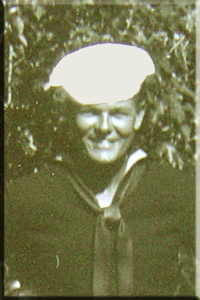
Harley Crawford's Story ...
I was born and raised in Stockton, California. My parents were Bess and Stanley Crawford. I had a younger brother, Charles Maurice, whom we called Maurice. I went to Lottie Grunsky Grammar School and graduated from Stockton High School in 1940. I was introduced to the keeping of bees by a favorite high school teacher, and I still keep bees to this day.
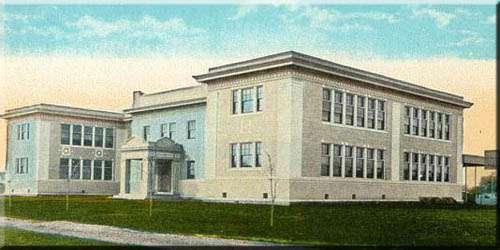
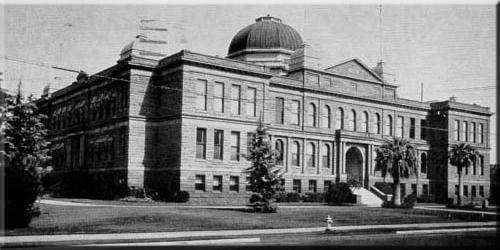
Lottie Grunsky Grammar School Stockton High School
In the summer of 1940 I had my first real job. I worked in a cannery canning peaches. In the fall of 1940 I attended Stockton Junior College. In the summer of 1941 I was back at the cannery. At the end of summer, instead of going back to school, I started working at a local ship yard that was building 136 foot wooden minesweepers for the United States Navy. I was just a helper when I started, but after awhile I bought a set of carpenter tools and became a ship finish carpenter. When I started work, the keels of three ships had been laid, YMS 95, 97, and 99. Later, after I had been in the Navy for six months, I returned to the shipyard for a visit. Just by luck, I was able to be aboard one of these ships when it was launched.
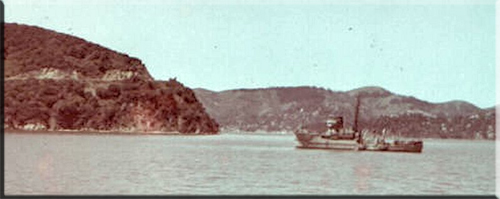 the Mine Warfare Vessel YMS-97
the Mine Warfare Vessel YMS-97Interestingly, after the war movie star John Wayne bought a ship like these and turned it into a pleasure yacht. I was not a mind reader, but I had a feeling I would be drafted into the Army. I decided to join the Navy before that happened and I signed up in February 1943. I took four months of basic training at the Farragut Naval Training Station in Sandpoint, Idaho, north of Coeur d'Alene, from March through June of 1943.
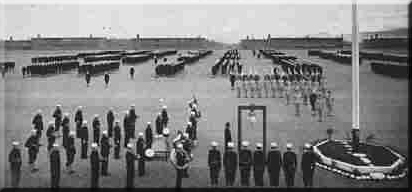 "Ready for Inspection" at Farragut NTS
"Ready for Inspection" at Farragut NTSSince I collected guns and knew a lot about them, I put in for ordnance school after basic training. People waiting for schools were put in an Outgoing Unit (OGU). I became part of ship's company at Farragut, which meant I was attached to the base and could be assigned any job that supported the operation of the base. During July and August I got my first assignment. I went around collecting money from Coke machines in the barracks and around the base. This was a huge base, and there were a lot of Coke machines. The training station had six training units designed for 5,000 men, a school area designed for 5,000 personnel, a hospital with 2,000 beds, a housing project for 300 Navy families, five large dormitories, officer's quarters, an auditorium, a recreational building, and two chapels. There were also auxiliary buildings necessary to maintain a station of over 30,000 people.
 the Central Administration Building at Farragut NTS
the Central Administration Building at Farragut NTSMy job for September and October was to drive a panel truck and do pick up and delivery to the tailor shop that altered uniforms. When I wasn't driving I worked the soda fountain and served meals in the officer's mess. I made a little extra money at fountain because they divided the profits among the workers. I had all this experience as a carpenter building ships and felt underused doing these jobs, but they had to be done and I did them. So I continued to wait for my assignment to ordnance school. Finally my orders came, and I went to ordnance school in Oklahoma in the fall of 1943. I finished in February of 1944 and was sent to the area of Santa Rosa, California, until February of 1945.
 the Soda Fountain at Farragut NTS
the Soda Fountain at Farragut NTSThe largest facility in the area was the Alameda Naval Air Station, located on Alameda Island, five miles east of San Francisco near Oakland. The Navy began building the 1,734 acre base in the late 1930's as a repair and maintenance facility for Navy aircraft, including carrier-based planes and helicopters. It employed as many as 15,000 people. There were several auxiliary bases in the Alameda network. The Naval Auxiliary Air Station at Santa Rosa was one of these auxiliary bases. It was opened in 1943 as an outlying airfield. Constructed by the Navy, the Santa Rosa Auxiliary Air Station consisted of two paved 7,000' runways, taxiways, ramps, hangars and a few other buildings. The station at Santa Rosa, in turn, had a small outlying field (OLF) at Cotati as an auxiliary to it. During the year between February of 1944 and February of 1945, I was at all three of these locations, but I seldom got to do the work I was trained to do. I followed orders and did the jobs I was assigned.

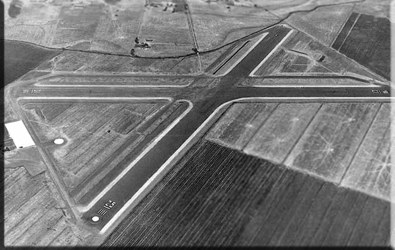
Alameda Naval Air Station the Outlying Field (OLF) at Cotati
I was only at Alameda for about a week, which was mostly for processing. Then I was assigned to ship's company at the base at Santa Rosa. My first assignment at Santa Rosa was guard duty at main entrance of base. Next I spent a month or two working in the magazine area where bombs and ammunition were stored, which was about as close as I got to ordnance. Next I went to transportation, where I drove about everything drivable. I drove bulldozers, command cars, thirty-two-passenger buses, and cattle cars. I drove fire fighters to forest fires. I took personnel on liberty to and from summer cabins at Russian River. The base provided shows for the troops, and I often went to San Francisco to pick up magicians, singers, and other entertainers. I did pick up and delivery between the Naval Air Station at Alameda and the auxiliary outlying fields. One time two airplanes locked wings and crashed. I drove the captain of the base and the captain of the group out to hunt for the downed planes and evacuate the pilots, both of whom survived.
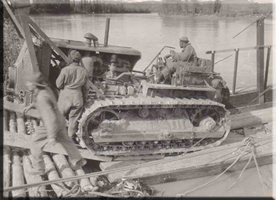 "I drove bulldozers, command cars ..."
"I drove bulldozers, command cars ..."For about a month I was assigned to the OLF at Cotati, where I was one of only seven people assigned to the base. It was a practice area for pilots who already had their wings. They took off and landed over and over. We called it "touch and go" because they never stayed in the air. Right after taking off, they landed so they could do it all over again. Those of us on the ground were the emergency crew in case of an accident. I worked on a fire truck.
In February of 1945 I got orders to attend advanced ordnance school in Jacksonville, Florida. During my five months at that school I met my wife, Shirley Starsoneck, at a dance on the base. Shirley, a Rhode Island native, was in the WAVES. (Women Accepted for Voluntary Emergency Service) in the Navy.
 "I met my wife, Shirley Starsoneck ..."
"I met my wife, Shirley Starsoneck ..."After advanced ordnance school, I was sent back to Santa Rosa for a few weeks in ship's company while I awaited my next set of orders. My stay in Santa Rosa consisted of more of the same kind of ad hoc assignments I had done when I was there before.
All the while I was in the Navy I made the best of what was available. One benefit was the ability to hitch rides on military airplanes, and I saw a lot of the country that way. In July of 1945 I got a free airplane ride from Jacksonville to New York and from New York to Hamilton Field in California, where I teamed up with a guy from California and got a ride on a navy plane to Colorado Springs. I then hitched a ride in cars along the road and went to see my father's cousin Marian Woolley and her husband Bill and their two boys, Bill and Dan. The Woolley family lived in the Denver area. The picture below was taken on that visit.
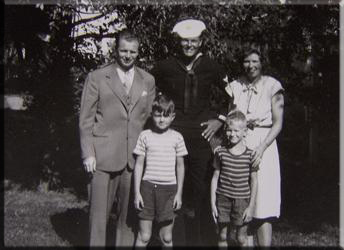
My visit to the Woolley familiy in July 1945
At the end of the summer I got orders to Hawaii. I left Santa Rosa and arrived in Hawaii about two weeks before the atomic bombs were dropped on Hiroshima and Nagasaki on 6 and 9 August 1945. I was bunked in a hangar on Ford Island in middle of Pearl Harbor when the first bomb was dropped in Japan. It was night time and I had just gotten into my bunk. Somebody had a radio and said, "Hey, they just dropped an atom bomb on Japan!" I didn't even know what an atom bomb was, but I found out soon enough. VJ-Day was 15 August 1945.
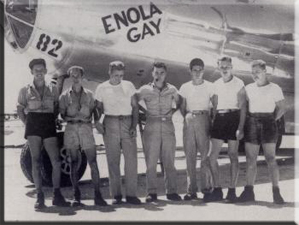
the Enola Gay and her crew who dropped the first Atom Bomb
The war in the Pacific was over, but I still had to stay in the Navy until March of 1946 in order to build up enough points to get out. A person received points for each month of service, and you had to have a certain number to get discharged. People who had been in combat, were married, or had a lot of service got extra points. While in Hawaii waiting for my discharge, I did get an ordnance-related job. I took temperature readings in bomb bunkers and silos.
I had built up eleven days' leave, so I was able to take advantage of being in a tourist destination. During those seven months I was able to hitch airplane rides to both the Big Island and Maui.
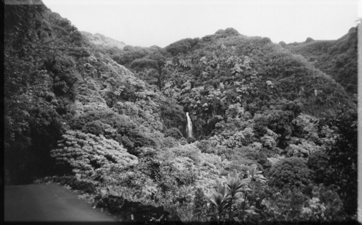
"I was able to hitch airplane rides to ... Maui"
I returned to civilian life in Stockton in March of 1946. In August of 1946 I moved to Santa Rosa, where Shirley and I got married in January of 1947 and started our life together. By 1949 we had two sons, Gregg and Keith, and needed a place to live. We bought a little house and lived in it for sixteen years. We next bought an acre lot and started to build our own house in August of 1963. In December of 1964 we moved in and, after over forty years, we still live in that home. Around our "ranch" we have bees, goats, cats, apples, prunes, pears, oranges, figs, and lemons.
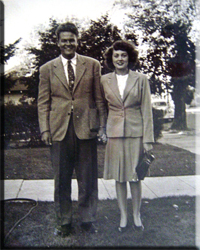
Harley and Shirley Crawford about 1947
I have always been interested in old things and have restored three Model T Fords, a 1914, a 1915, and a 1917. I have also restored many old farm engines. My latest hobby of interest is scales. I enjoyed riding my Honda Gold Wing motorcycle until I started having back trouble last year. I was also a professional photographer for many years and photographed over 300 weddings
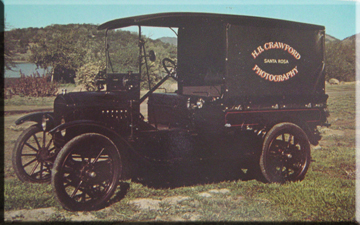
a 1917 Model T-Ford ... H.B.Crawford Photography
I worked for Pacific Gas and Electric for thirty-five years. I was-hired as a mapper for electric lines, which was indoor work at a drafting table. Later I became an estimator, which allowed me to work outdoors, which I preferred to indoor work. I calculated how much line would be required to bring electric service into new homes.
Since my retirement in 1981 Shirley and I have done a lot of world travel-Europe, Central America, New Zealand, and Australia. Our last trip was to France. While we were in Paris, I made a trip to Belgium to visit the grave of my brother, Charles Maurice Crawford, who was killed at age 19 in the Ardennes on 2 December 1944. He is buried at Henri-Chapelle.
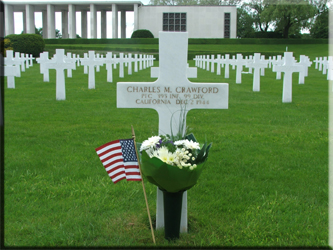
My brother Maurice's final resting place in Belgium
Maurice Crawford's story can be found in the "Buried at Henri-Chapelle" section
published May 14, 2006